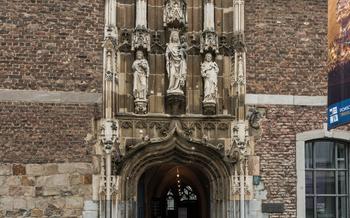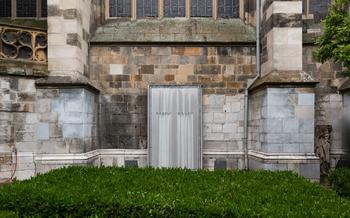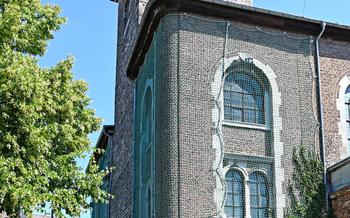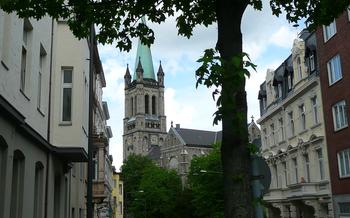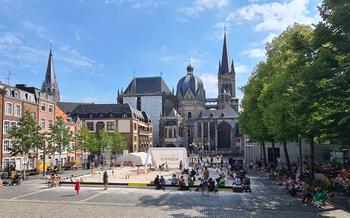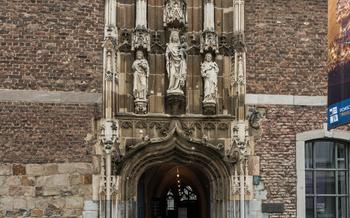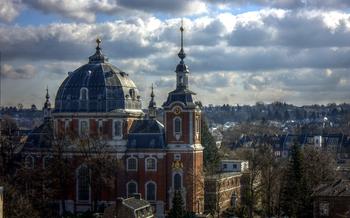
Treasury of Aachen Cathedral
- Aachen Cathedral Treasury
- History of the Aachen Cathedral Treasury
- Imperial Regalia
- Carolingian Art
- Goldwork
- Ivory Carvings
- Textiles
- Manuscripts
- Medieval Jewelry
- Stained Glass
- Sculptures
- Architecture of the Treasury
- Visiting the Treasury
- Insider Tip
Aachen Cathedral Treasury
The Aachen Cathedral Treasury is one of the most significant treasuries in Europe, housing an exceptional collection of religious artifacts, imperial regalia, and medieval artwork. It holds immense historical significance, dating back to the reign of Charlemagne, who established Aachen as his imperial capital in the 8th century.
The establishment of the Aachen Cathedral Treasury mirrored Charlemagne's desire to create a grand imperial center rivaling the splendor of the Byzantine court in Constantinople. The treasury was initially housed within the Aachen Cathedral, serving as a repository for precious objects used in religious ceremonies and imperial coronations.
Throughout history, the treasury's collection grew through donations from successive emperors, bishops, and wealthy patrons. It survived religious conflicts, wars, and looting attempts, testament to its enduring importance as a symbol of imperial power and religious devotion.
Currently, the Aachen Cathedral Treasury is located within the Cathedral's immediate vicinity, housed in a modern, purpose-built building designed to showcase its magnificent collection to visitors from around the world.
History of the Aachen Cathedral Treasury
The Aachen Cathedral Treasury has a rich and storied history, dating back to the early days of Christianity in the region. The origins of the Treasury can be traced to the 8th century, when Charlemagne, the first Holy Roman Emperor, established Aachen as his imperial capital. During his reign, Charlemagne commissioned the construction of a magnificent cathedral in Aachen, which was to serve as his royal chapel and the spiritual center of his empire. As part of the cathedral complex, a treasury was built to house the valuable objects used in religious ceremonies and to store the relics of saints and martyrs.
Over the centuries, the Aachen Cathedral Treasury grew in size and importance. It received numerous donations from emperors, kings, and other wealthy individuals, who sought to enrich the collection and demonstrate their devotion to the Christian faith. The Treasury became renowned for its collection of precious objects, including gold and silver vessels, jeweled reliquaries, ivory carvings, and illuminated manuscripts. It also housed the Imperial Regalia, the ceremonial objects used in the coronation of Holy Roman Emperors.
Unfortunately, the Aachen Cathedral Treasury has not been spared from the ravages of time and war. It has been looted and dispersed on several occasions, most notably during the French Revolution when many of its treasures were stolen and melted down. However, the Treasury has been painstakingly rebuilt over the centuries, and it now houses a remarkable collection of over 1000 objects, including many that date back to the time of Charlemagne.
Imperial Regalia
The Imperial Regalia, one of the most significant treasures in the Aachen Cathedral Treasury, comprises several opulent and symbolic objects that were traditionally used in the coronations of Holy Roman Emperors. This impressive collection includes the Imperial Crown, Imperial Orb, Imperial Scepter, Charlemagne's Sword, and the Imperial Mantle.
The Imperial Crown, crafted in the 10th century, is a testament to the exquisite artistry of Carolingian goldsmiths. Adorned with precious stones and pearls, it exudes an aura of majesty and power. The Imperial Orb, symbolizing the dominion over the world, features a golden sphere surmounted by a cross, representing Christ's rule over the cosmos. The Imperial Scepter, a symbol of authority and justice, is topped by a majestic eagle, embodying the strength and sovereignty of the Holy Roman Empire.
Charlemagne's Sword, believed to have belonged to the great emperor himself, is an awe-inspiring relic of Carolingian history. With its ornate scabbard and intricate carvings, it represents the military prowess and leadership of Charlemagne. The Imperial Mantle, woven with intricate gold threads and adorned with precious stones, was worn by emperors during their coronation ceremonies, symbolizing their divine authority and connection to the sacred.
These magnificent artifacts, steeped in history and symbolism, played a crucial role in imperial coronations, reinforcing the power and legitimacy of the Holy Roman Emperors. Their presence in the Aachen Cathedral Treasury serves as a testament to the enduring legacy of Charlemagne and the profound cultural and religious significance of the Aachen Cathedral.
Carolingian Art
Carolingian art emerged during the reign of Charlemagne in the late 8th and early 9th centuries, flourishing as the official artistic style of the Carolingian Empire. This artistic movement sought to revive the grandeur and majesty of ancient Roman art, blending classical and Christian elements to create a unique and influential style that would leave a lasting impact on the development of art in Europe.
Characteristics of Carolingian art:
-
Biblical and historical themes: Carolingian art often depicted biblical scenes and narratives, as well as historical events from the Roman Empire.
-
Symbolic and didactic content: Many Carolingian artworks carried symbolic and didactic messages, aiming to convey religious and moral lessons to viewers.
-
Integration of classical and Christian elements: Carolingian art combined elements from classical Roman art, such as architectural motifs and imperial iconography, with Christian imagery and symbolism.
-
Large-scale metalwork and sculpture: Carolingian artists excelled in metalworking, creating impressive large-scale sculptures and reliefs in bronze and gold.
-
Elaborate illuminated manuscripts: The Carolingian period saw a flourishing of manuscript illumination, with lavishly decorated and illustrated books produced in monasteries and scriptoria.
Examples of Carolingian art in the Aachen Cathedral Treasury:
-
The Cross of Lothair: A stunning example of Carolingian metalwork, this processional cross is adorned with intricate gold filigree, enamel, and gemstones, depicting scenes from the life of Christ.
-
The Codex Aureus of Charlemagne: A magnificent illuminated manuscript, the Codex Aureus contains the Gospels written in gold and silver ink on purple vellum, showcasing the exceptional craftsmanship of Carolingian scribes and illuminators.
-
The ivory diptychs: A pair of elaborately carved ivory panels, the diptychs depict scenes from the life of Christ and the Virgin Mary, demonstrating the skill and artistry of Carolingian ivory carvers.
Impact of Carolingian art on the development of art in Europe:
Carolingian art played a pivotal role in the development of art in Europe, serving as a bridge between the classical and medieval periods. It laid the foundation for the emergence of the Romanesque and Gothic styles, influencing the artistic traditions of Western Europe for centuries to come.
Goldwork
The Aachen Cathedral Treasury is home to an impressive collection of goldwork, representing the pinnacle of medieval metalworking and craftsmanship. Goldsmiths from Aachen and beyond were renowned for their exquisite skills, and the Treasury showcases their finest creations.
One of the most remarkable pieces in the collection is the Golden Altar of Aachen, crafted in the 10th century. This masterpiece of gold and silver depicts scenes from the life of Christ and the Virgin Mary, with intricate detailing and a vibrant use of color. Another highlight is the Reliquary Shrine of Charlemagne, adorned with intricate gold filigree and precious gemstones. This magnificent shrine houses the relics of the Holy Roman Emperor, Charlemagne, who is buried in the cathedral.
The Treasury also features a variety of gold crosses, pendants, brooches, and other religious artifacts. Each piece is a testament to the skill and artistry of the medieval goldsmiths, who used a variety of techniques to create intricate and beautiful works of art.
The goldsmiths of Aachen were also pioneers in the development of new techniques, such as champlevé and cloisonné. These techniques involved the use of colored enamels to create intricate designs on gold or silver surfaces. The Aachen goldsmiths were among the first to master these techniques, and their work had a profound influence on the development of goldsmithing throughout Europe.
Some of the most notable goldsmiths who worked in Aachen include Einhard, Odo of Metz, and Roger of Helmarshausen. These master craftsmen were responsible for creating some of the most iconic pieces in the Aachen Cathedral Treasury, and their work continues to inspire goldsmiths and artists to this day.
Ivory Carvings
The Treasury of Aachen Cathedral houses an impressive collection of ivory carvings that date back to the 9th and 10th centuries. These carvings are considered to be among the finest examples of Carolingian art, and they provide valuable insights into the artistic and cultural achievements of the period.
The ivory carvings in the Treasury are typically small in size, ranging from a few centimeters to a few inches in height. They are made from elephant ivory, which was a highly prized material in the Middle Ages. The carvings depict a variety of subjects, including religious scenes, historical events, and mythological figures.
One of the most famous ivory carvings in the Treasury is the "Reliquary of Charlemagne", which is a small box that was used to hold the relics of the emperor. The reliquary is decorated with a series of intricate carvings that depict scenes from the life of Christ. Another notable ivory carving is the "Lindau Gospels", which is a book of gospels that was created in the 9th century. The manuscript is richly decorated with ivory carvings that depict the four evangelists and other biblical figures.
The ivory carvings in the Treasury of Aachen Cathedral are a testament to the skill and artistry of the Carolingian artists. These works of art provide a valuable glimpse into the religious, political, and cultural life of the Middle Ages.
Textiles
The Treasury of Aachen Cathedral boasts a remarkable collection of medieval textiles, each piece a testament to the skill and artistry of the period's weavers and embroiderers. These precious fabrics, often intricately adorned with shimmering threads and vibrant hues, served not only as adornments but also held profound symbolic and religious significance.
Types of Textiles in the Treasury
The Treasury's textile collection encompasses a diverse range of fabrics, including luxurious silks, fine linens, and sturdy woolens. Each type of textile possessed unique characteristics that made it suitable for specific purposes. Silks, with their lustrous sheen and vibrant colors, were reserved for the most sacred vestments and ceremonial garments. Linens, valued for their breathability and purity, were used for altar cloths and liturgical linens. Woolens, warm and durable, were employed for everyday garments and tapestries.
Symbolic Meaning of the Textiles
Beyond their practical uses, textiles in the Treasury were imbued with profound symbolic meanings. Colors played a crucial role in conveying these messages. White, for instance, symbolized purity and innocence, while red represented the blood of Christ and the passion of the martyrs. Blue, associated with the Virgin Mary, denoted heavenly devotion, while green embodied hope and new beginnings.
Techniques of Weaving and Embroidery Used in the Treasury
The textiles in the Treasury showcase a variety of weaving and embroidery techniques, each demonstrating the exceptional craftsmanship of their creators. Skilled weavers employed intricate patterns and motifs to create visually striking fabrics, while embroiderers utilized threads of gold, silver, and silk to embellish garments and tapestries with elaborate designs. These techniques, passed down through generations, required immense patience, precision, and artistic vision.
Manuscripts
The Aachen Cathedral Treasury houses a significant collection of medieval manuscripts, which provide valuable insights into the intellectual and religious life of the Middle Ages. These manuscripts, written on vellum or parchment, cover a wide range of subjects, including theology, history, literature, and science. Many of the manuscripts are richly illuminated with intricate drawings and paintings, which not only enhance their aesthetic appeal but also serve to convey important religious and historical messages.
One of the most notable manuscripts in the collection is the Codex Aureus of Aachen, also known as the Golden Gospels of Charlemagne. Created in the early 9th century, this lavishly illuminated manuscript contains the four Gospels written in gold and silver ink on purple vellum. The Codex Aureus is considered one of the finest examples of Carolingian art and is a testament to the high level of craftsmanship and artistry that existed during this period.
Another important manuscript in the collection is the Charlemagne Bible, which dates back to the late 8th century. This large-format manuscript contains the entire Bible, written in Latin, and is notable for its elegant script and exquisite decorations. The Charlemagne Bible is a valuable source of information for scholars studying the history of the Bible and the development of early Christianity.
In addition to these two famous manuscripts, the Aachen Cathedral Treasury also houses a collection of other medieval manuscripts, including psalters, missals, and breviaries. These manuscripts, which were used for religious services and private devotion, provide insights into the liturgical practices and beliefs of the medieval Church. They also contain valuable information about the history of Aachen and the surrounding region.
Medieval Jewelry
The Aachen Cathedral Treasury is home to a stunning collection of medieval jewelry, showcasing the exquisite craftsmanship and artistry of the period. These precious adornments were not merely decorative accessories but held significant cultural, social, and religious value.
One of the most remarkable pieces in the collection is the Golden Cross of Lothair, crafted in the 9th century. This intricate cross features intricate filigree work and is adorned with precious gemstones, including rubies, sapphires, and emeralds. It is believed to have been commissioned by Emperor Lothair I and was worn by him as a symbol of his authority.
Another highlight of the collection is the Reliquary Pendant of Charlemagne, dating back to the 8th century. This exquisite pendant is made of gold and adorned with cloisonné enamel, depicting scenes from the life of Christ. It is believed to have been worn by Charlemagne himself and was used to hold a relic of the True Cross.
The Treasury also boasts a collection of magnificent brooches, rings, bracelets, and necklaces, each showcasing the exceptional skills of medieval goldsmiths. These pieces were not only symbols of wealth and status but also held personal and sentimental value for their owners.
Medieval jewelry played a significant role in society, serving as a means of personal adornment, displaying social status, and expressing religious devotion. The jewelry in the Aachen Cathedral Treasury offers a glimpse into the lives and beliefs of those who lived during this fascinating period of history.
Stained Glass
The Aachen Cathedral Treasury is home to a significant collection of medieval stained glass windows, which are considered masterpieces of the art form. These windows were created between the 10th and 13th centuries and depict a variety of religious scenes and figures. The windows are notable for their vibrant colors and intricate designs, which were achieved using a variety of techniques, including painting, staining, and firing.
The stained glass windows in the Treasury offer a glimpse into the artistic and technical achievements of the Middle Ages. They also provide valuable insights into the religious beliefs and practices of the period. The windows were designed to teach and inspire the faithful, and they played an important role in the liturgy of the church.
Some of the most notable stained glass windows in the Treasury include the "Three Kings Window", which depicts the three wise men following the star to Bethlehem, and the "Crucifixion Window", which shows Jesus Christ on the cross flanked by Mary and John the Evangelist. These windows are considered to be among the finest examples of medieval stained glass in Europe.
Sculptures
The Treasury of Aachen Cathedral also houses a remarkable collection of medieval sculptures. These sculptures are made from various materials, including stone, wood, and ivory, and depict a wide range of subjects, from religious figures to mythical creatures.
One of the most notable sculptures in the Treasury is the "Golden Madonna of Aachen", a 13th-century wooden statue of the Virgin Mary and Child. The statue is covered in gold leaf and is one of the most revered objects in the Treasury.
Another highlight of the collection is the "Reliquary Bust of Charlemagne", a 14th-century stone bust of the Holy Roman Emperor Charlemagne. The bust is a masterpiece of Gothic sculpture and is one of the most iconic representations of Charlemagne.
The Treasury also houses a number of ivory sculptures, including the "Reliquary of St. Stephen", a 10th-century ivory casket that contains the relics of St. Stephen. The casket is decorated with intricate carvings depicting scenes from the life of St. Stephen.
The sculptures in the Treasury of Aachen Cathedral are a testament to the skill and artistry of medieval craftsmen. They are a valuable resource for the study of medieval art and history and are sure to impress visitors with their beauty and craftsmanship.
Architecture of the Treasury
The Aachen Cathedral Treasury is housed in a beautiful Romanesque building, which was built in the 14th century. The building is made of limestone and features a gabled roof, round-arched windows, and a sturdy tower. The Treasury's interior is spacious and well-lit, with a series of vaulted chambers that display the collection.
The Treasury's architecture is a testament to the importance of the city of Aachen in the Middle Ages. The building was constructed to be both secure and impressive, reflecting the value of the treasures it contained. The Treasury has undergone several renovations and expansions over the centuries, but it retains its original Romanesque style.
The architecture of the Treasury is also significant in the development of architecture in Aachen. The building is one of the earliest examples of the use of the ribbed vault in the city, and it influenced the design of many other buildings in Aachen, including the Aachen Cathedral itself.
The Treasury's architecture is a reminder of the rich history of Aachen and the importance of the city as a center of art and culture in the Middle Ages. The building is a beautiful and impressive example of Romanesque architecture, and it is a must-see for anyone interested in the history of Aachen or medieval art.
Visiting the Treasury
Practical information for visiting the Treasury
The Aachen Cathedral Treasury is open to the public from Tuesday to Sunday, from 10 am to 5 pm. Guided tours are available in German and English, and cost €5 per person. Admission to the Treasury is €6 for adults, €4 for students and seniors, and free for children under There are also family tickets available for €
Guided tours available
Guided tours of the Treasury are highly recommended, as they provide a wealth of information about the history and significance of the collection. Tours are available in German and English, and last for about an hour. Advance booking is not necessary, but it is advisable to arrive early to avoid disappointment.
Admission fees and discounts
Admission to the Treasury is €6 for adults, €4 for students and seniors, and free for children under There are also family tickets available for €Discounts are available for groups of 10 or more people.
Insider Tip
Best time to visit:
- The Treasury is open to the public from Tuesday to Sunday.
- To avoid crowds, it is recommended to visit the Treasury during the week or in the off-season.
- The Treasury is closed on Mondays and on some holidays, so it is advisable to check the opening hours before planning a visit.
Nearby attractions and restaurants:
- A visit to the Treasury can be combined with a visit to the Aachen Cathedral, which is located right next door.
- The Aachen Cathedral is a UNESCO World Heritage Site and is one of the most important examples of Carolingian architecture.
- In the vicinity of the Treasury, there are numerous restaurants and cafes where you can enjoy a meal or a drink after your visit.
Souvenirs and gifts:
- In the Aachen Cathedral Treasury shop, you can find a variety of souvenirs and gifts related to the Treasury.
- There are books, postcards, jewelry, and other items that make for a perfect memento of your visit.
